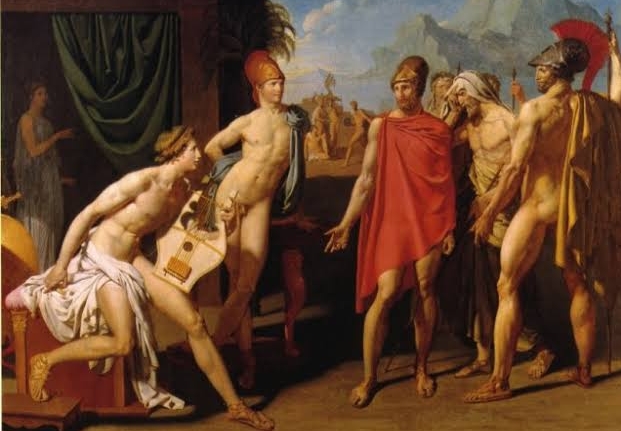(525-456 B.C.E) Greek Playwright

The son of wealthy family in sixth century B.C.E.Attica,Aeschylus was a tragedian at a time when Greek Theater was still developing from its beginning as a form of elaborate dance.In contrast to first dramas,Performed in honor of Dionysus and under the influence of copious amount of wine, Aeschylus’s work emphasized natural law and punishment at the hands of the gods, by examining the role of characters in a larger world.

His participation as a soldier in the battle of Marathon in 490 B.C.E, when the invading Persians were successfully repelled by vastly outnumbered Greek forces, probably informed his approach.The persians told the story of the battle and was first performed 18 years later.
Of Aeschylus’s 70 some plays , only seven survive.They are earliest known Greek tragedies,as he is one of only three tragedians(With EURIPIDES AND SOPHOCLES)Whose works have survived to modern era.Seven against Thebes is another battle narrative, concerning that of “the Seven”mythic heroes against Thebes in the aftermath of the death of the sons of Oedipus.



The Suppliants is a simpler story about the daughters of Danaus fleeing a forced marriage, while the Oresteia is a trilogy of plays about the house of Atreus, starting with the return of Agamemnon from the Trojan war.The Oresteia has enduring appeal in the modern world: 20th Century Playwright Eugene O ‘ Neill’s Mourning becomes Electra was based on it, Substituting the Civil war for the Trojan war in the backstory of O’Neill’s trilogy.


Composers Richard Strauss and sergey Taneyev each based operas on the Oresteia, and many more writers and artists have found compelling the idea of the Furies who in Aeschylus’s trilogy bring down the wrath of the gods upon Orestes for having killed his mother.

In a sense the Oresteia is not just the earliest surviving trilogy of the Greek plays.It is also one of the earliest horror stories, with the Furies tracking Orestes by following the scent of his mother Clytemnestra’s blood, and the play’s emphasis on the idea,so resonant in horror literature and ghost stories,of the supernatural exacting horrible justice on Transgressors.Legend claims that Aeschylus met his death under the strangest of circumstances when a passing eagle dropped a turtle on his head.
Aesop
(c.mid-sixth century B.C.E)Greek writer.

A slave in ancient Greece in the sixth century B.C.E., Aesop was the creator or populizer of the genre of fables were brief stories, appropriate for children and structured around a simple moral lesson.Most of them features anthropomorphized animals-animals who spoke and acted like humans often motivated by some exaggerated human characteristics.Unlike the animal tales of many mythic traditions-the Coyote stories North America for instance -Aesop’s animals did not represent spiritual or divine being ,nor did they explain the natural of the world.They were comparable instead to modern children’s literature and cartoons,though with an educational bent.

The fables remain some of the best known western world,often landing themselves to proverbs.Some of the most famous include ,the fox and Grapes,from which the idiom sour grapes is derived ,to refer to something that, like the grapes the fox cannot reach ,is assumed to be not worth the trouble.,The tortoise and hare,which concludes that ” slow and steady wins the race”and has been adapted to a number of media, including a Disney cartoon.,The ant and the grasshopper ,the latter of which suffers through a harsh winter he had not prepared for as the ant did.,and perhaps most evocatively,the scorpion and frog.

In this tale a scorpion asks a frog to carry him across the river,and river and frog refuses out of fear of being stung,the scorpion brushes the concern aside,pointing out that should he sting the frog,both will dies as the scorpion drowns.Nonetheless,the frog’s fearless proves warranted,When the scorpion stings him partway across the river,he reminds the frog that such behaviour is plainly the nature of a scorpion.
